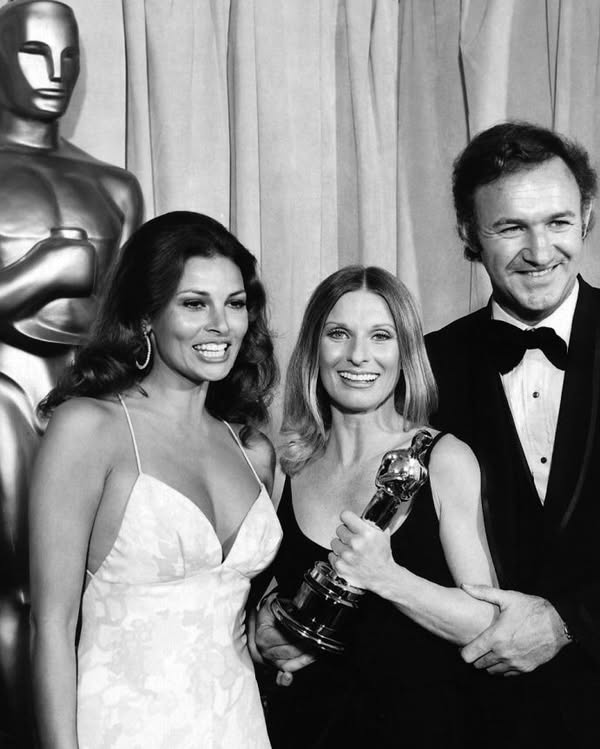The 1972 Academy Awards stands as a defining moment in the history of the Oscars, capturing the essence of a Hollywood at the crossroads of tradition and change. From the groundbreaking films to the dazzling red carpet fashion, the event remains a celebration of cinema that still holds a special place in the hearts of film lovers.
A Historic Year for Film
The 44th Academy Awards saw The French Connection dominate the night, winning five Oscars, including Best Picture, Best Director for William Friedkin, and Best Actor for Gene Hackman. The film’s gritty realism, especially its iconic car chase scenes, set a new standard for thrillers and cemented its place in film history. Gene Hackman’s emotional acceptance speech, in which he thanked his drama coach and mother, was a touching highlight of the evening.
 The 1972 Oscars. Credit / Getty Images
The 1972 Oscars. Credit / Getty Images
Other notable films included A Clockwork Orange, Stanley Kubrick’s controversial and thought-provoking dystopian classic, and Fiddler on the Roof, which brought back the grandeur of the musical genre. The Last Picture Show, a poignant coming-of-age film by Peter Bogdanovich, earned eight nominations and showcased the talents of Cloris Leachman and Ben Johnson, both of whom took home Oscars for their supporting roles.
A Return to Classic Hollywood Glamour
The 1972 Oscars marked a return to the elegance of Hollywood’s golden era. Gone were the feathers, fringe, and hippie headbands from previous years. This ceremony showcased vintage glamour, with stars adorning flowing chiffons, luxurious brocades, diamonds, and furs. One standout moment was when Jane Fonda made a bold statement in one of the few pantsuits seen on the red carpet that year.
 Keystone/Getty Images
Keystone/Getty Images
The fashion exuded timeless sophistication, offering a stark contrast to the more casual and avant-garde styles of the late 1960s and early 1970s. As one reporter noted, “there wasn’t a hotpants outfit in sight.”
Music, Protests, and Performances
The music at the 1972 Oscars was as unforgettable as the films themselves. Isaac Hayes made history as the first African American to win an Oscar for Best Original Song with his iconic “Theme from Shaft.” His electrifying performance on stage, shirtless and covered in chains, was one of the evening’s standout moments. Hayes’ performance, which ended with him disappearing beneath the stage in a cloud of smoke, left the audience in awe and solidified his place in Oscar history.
 Rebecca De Mornay during 44th Annual Academy Awards at Dorothy Chandler Pavillion in Los Angeles, California, United States. (Photo by Ron Galella/Ron Galella Collection via Getty Images)
Rebecca De Mornay during 44th Annual Academy Awards at Dorothy Chandler Pavillion in Los Angeles, California, United States. (Photo by Ron Galella/Ron Galella Collection via Getty Images)
While the ceremony was filled with glamour and celebration, it also took place against a backdrop of protest. Outside the Los Angeles Music Center, demonstrators gathered to voice their opposition to films like Dirty Harry, which, despite not being nominated, had been criticized for its portrayal of police violence. It was a reminder that the Oscars often serve as a reflection of the social and political climate of the time.
Betty Grable’s Farewell
One of the most poignant moments of the evening came when Hollywood legend Betty Grable made one of her final public appearances. The iconic actress, famous for her pin-up girl image during World War II, arrived in a striking turquoise gown. Grable’s presence at the ceremony was bittersweet, as she passed away just a year later from lung cancer at the age of 56. Her appearance marked the end of an era in Hollywood, a moment of nostalgia for fans who had adored her for decades.
Charlie Chaplin’s Emotional Return
Perhaps the most touching moment of the evening was when Charlie Chaplin, the legendary silent film star, was honored for his contributions to cinema. Chaplin had been ostracized from Hollywood years earlier due to political controversies, but in 1972, he was finally welcomed back with open arms. The audience gave Chaplin a 12-minute standing ovation—the longest in Oscar history. The 82-year-old received an honorary award, and his heartfelt words on stage brought tears to many eyes. It was a powerful moment of reconciliation and respect for one of the greatest pioneers of the film industry.
A Fusion of Old and New Hollywood
The 1972 Oscars captured the fusion of old and new Hollywood. Veteran stars like Jane Russell and Macdonald Carey shared the spotlight with a new generation of actors, including Jane Fonda, Jack Nicholson, Gene Hackman, and Cloris Leachman. The ceremony reflected the changing landscape of the film industry, which was moving away from traditional narratives and embracing more diverse storytelling.
A photo featuring Raquel Welch, Cloris Leachman, and Gene Hackman encapsulated this shift. Welch, in particular, represented a changing ideal of femininity in Hollywood—her confidence and glamour symbolized the growing influence of women in the industry. The image of these three actors together reflected the broader cultural shifts taking place in the early 1970s.
The Lasting Impact of the 1972 Oscars
The 1972 Oscars were more than just a ceremony; they were a moment in time that encapsulated the glamour, emotion, and transformation of Hollywood. From iconic performances and historic wins to unforgettable fashion and poignant tributes, the event remains one of the best in Academy Awards history.
 Charlie Chaplin circa 1972 in New York City. (Photo by Images Press/IMAGES/Getty Images)
Charlie Chaplin circa 1972 in New York City. (Photo by Images Press/IMAGES/Getty Images)
It wasn’t just about the films or the stars—it was about celebrating the magic of cinema and the power of storytelling. The 1972 Oscars set a high bar for every ceremony that followed, and it continues to be remembered as one of the most iconic nights in Hollywood history.



